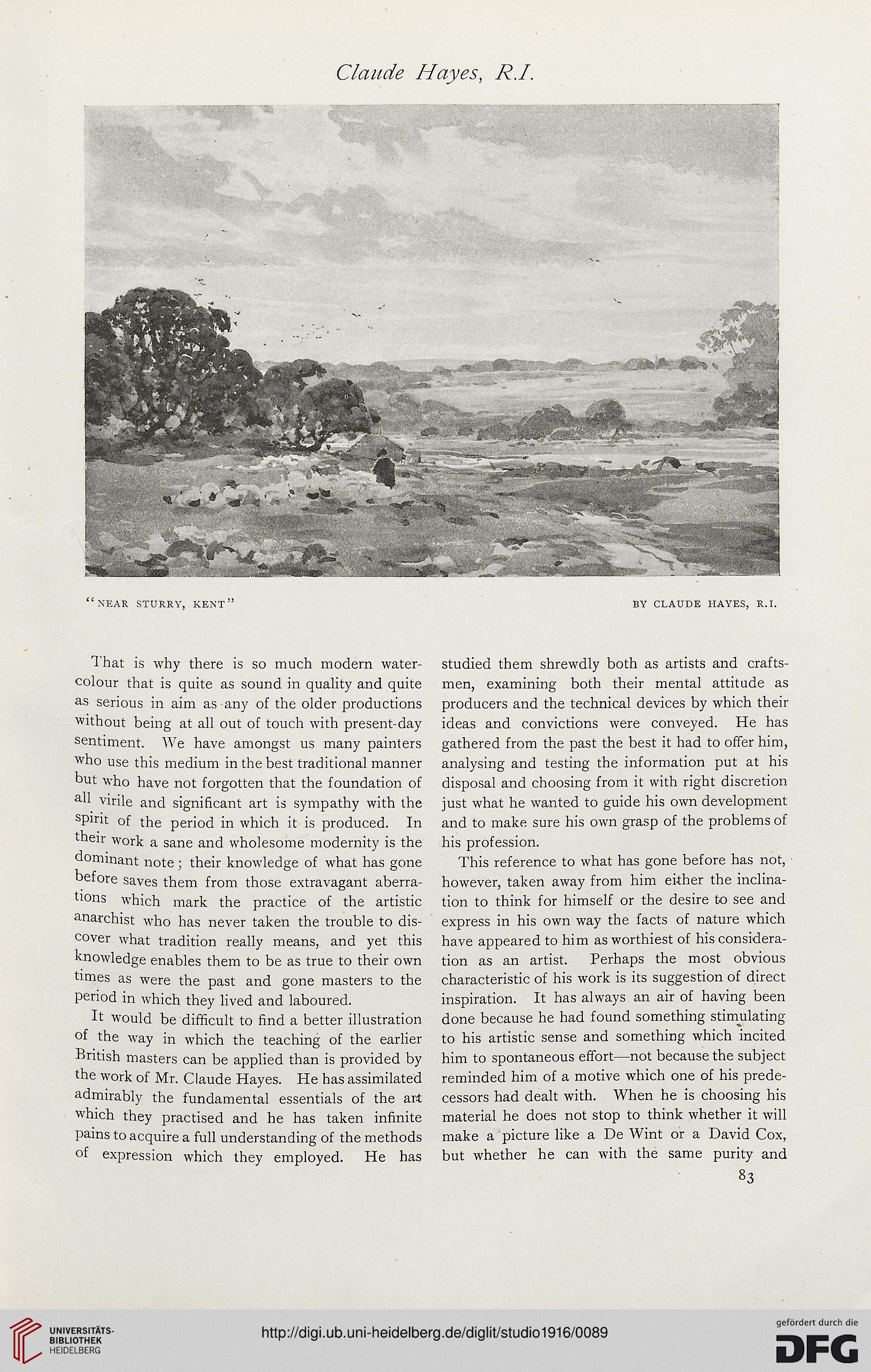Claude Hayes, R.I.
That is why there is so much modern water-
colour that is quite as sound in quality and quite
as serious in aim as any of the older productions
without being at all out of touch with present-day
sentiment. We have amongst us many painters
who use this medium in the best traditional manner
but who have not forgotten that the foundation of
all virile and significant art is sympathy with the
spirit of the period in which it is produced. In
their work a sane and wholesome modernity is the
dominant note ; their knowledge of what has gone
before saves them from those extravagant aberra-
tions which mark the practice of the artistic
anarchist who has never taken the trouble to dis-
cover what tradition really means, and yet this
knowledge enables them to be as true to their own
times as were the past and gone masters to the
period in which they lived and laboured.
It would be difficult to find a better illustration
of the way in which the teaching of the earlier
Hritish masters can be applied than is provided by
the work of Mr. Claude Hayes. He has assimilated
admirably the fundamental essentials of the art
which they practised and he has taken infinite
pains to acquire a full understanding of the methods
of expression which they employed. He has
studied them shrewdly both as artists and crafts-
men, examining both their mental attitude as
producers and the technical devices by which their
ideas and convictions were conveyed. He has
gathered from the past the best it had to offer him,
analysing and testing the information put at his
disposal and choosing from it with right discretion
just what he wanted to guide his own development
and to make sure his own grasp of the problems of
his profession.
This reference to what has gone before has not,
however, taken away from him either the inclina-
tion to think for himself or the desire to see and
express in his own way the facts of nature which
have appeared to him as worthiest of his considera-
tion as an artist. Perhaps the most obvious
characteristic of his work is its suggestion of direct
inspiration. It has always an air of having been
done because he had found something stimulating
to his artistic sense and something which incited
him to spontaneous effort—not because the subject
reminded him of a motive which one of his prede-
cessors had dealt with. When he is choosing his
material he does not stop to think whether it will
make a picture like a De Wint or a David Cox,
but whether he can with the same purity and
83
That is why there is so much modern water-
colour that is quite as sound in quality and quite
as serious in aim as any of the older productions
without being at all out of touch with present-day
sentiment. We have amongst us many painters
who use this medium in the best traditional manner
but who have not forgotten that the foundation of
all virile and significant art is sympathy with the
spirit of the period in which it is produced. In
their work a sane and wholesome modernity is the
dominant note ; their knowledge of what has gone
before saves them from those extravagant aberra-
tions which mark the practice of the artistic
anarchist who has never taken the trouble to dis-
cover what tradition really means, and yet this
knowledge enables them to be as true to their own
times as were the past and gone masters to the
period in which they lived and laboured.
It would be difficult to find a better illustration
of the way in which the teaching of the earlier
Hritish masters can be applied than is provided by
the work of Mr. Claude Hayes. He has assimilated
admirably the fundamental essentials of the art
which they practised and he has taken infinite
pains to acquire a full understanding of the methods
of expression which they employed. He has
studied them shrewdly both as artists and crafts-
men, examining both their mental attitude as
producers and the technical devices by which their
ideas and convictions were conveyed. He has
gathered from the past the best it had to offer him,
analysing and testing the information put at his
disposal and choosing from it with right discretion
just what he wanted to guide his own development
and to make sure his own grasp of the problems of
his profession.
This reference to what has gone before has not,
however, taken away from him either the inclina-
tion to think for himself or the desire to see and
express in his own way the facts of nature which
have appeared to him as worthiest of his considera-
tion as an artist. Perhaps the most obvious
characteristic of his work is its suggestion of direct
inspiration. It has always an air of having been
done because he had found something stimulating
to his artistic sense and something which incited
him to spontaneous effort—not because the subject
reminded him of a motive which one of his prede-
cessors had dealt with. When he is choosing his
material he does not stop to think whether it will
make a picture like a De Wint or a David Cox,
but whether he can with the same purity and
83




